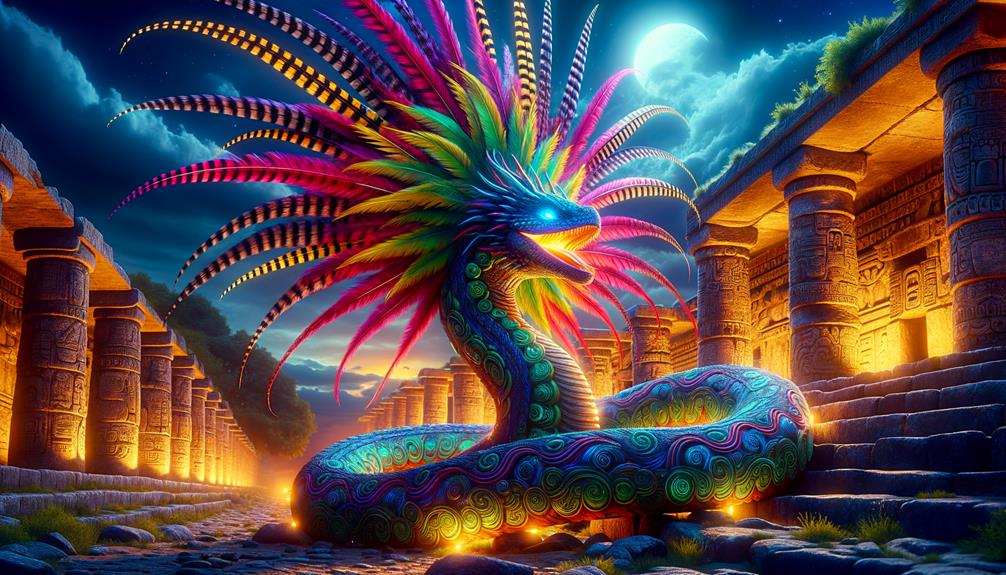Did you know over half of Aztec temples honored Quetzalcoatl, the Feathered Serpent God? This fascinating figure blended celestial and earthly elements – a perfect union of sky and land. Quetzalcoatl wasn't just a deity but a symbolic hero representing creation, rebirth, and wisdom. His layered story offers insight into the human experience and our desire for renewal. Why did Quetzalcoatl's influence persist after the Spanish conquest? Let's unpack this enduring archetype.
Quetzalcoatl holds relevance beyond ancient myth. His story resonates with contemporary audiences seeking meaning and connection. The Feathered Serpent embodied duality – the divine and mortal, spirit and flesh. This dichotomy mirrors our own struggles to reconcile inner and outer worlds.
Quetzalcoatl's rebirth narrative holds universal appeal. Across cultures, cycles of death and renewal symbolize humanity's resilience. Whether emerging from the underworld or transcending personal crises, rebirth resonates profoundly. The serpent shedding its skin evokes our capacity for transformation.
As a culture hero, Quetzalcoatl brought knowledge and fostered civilization. This resonates in our information age, where wisdom is a treasured commodity. Quetzalcoatl's journey from naive to enlightened reflects our eternal quest for understanding.
While Mesoamerican civilizations faded, Quetzalcoatl persisted in collective memory. Shared myths and archetypes unite us across time and space. The Feathered Serpent awakens our wonder about the cosmos and our place within it. His symbolic power transcends one pantheon, reflecting the breadth of human spirituality.
Origins and Etymology
Quetzalcoatl's name originates from Nahuatl, the language of the Aztecs, combining 'quetzal' – the vibrant bird representing the heavens – and 'coatl' – the serpent symbolizing the earth. In Aztec mythology, this feathered serpent deity embodied the cosmic interplay between celestial and terrestrial realms.
Quetzalcoatl's birth was linked to celestial events, with the rain god Tlaloc playing a pivotal role during a total eclipse. This cosmic occurrence marked Quetzalcoatl's transformation into the creator of the Fifth Sun, a cycle reflecting the Aztecs' understanding of the universe's cyclical nature.
As the corn deity, Quetzalcoatl held immense significance for the Aztecs. Corn was a staple food source, and Quetzalcoatl symbolized not just nourishment but also spiritual sustenance, making this deity indispensable to their culture and way of life.
Myths and Legends
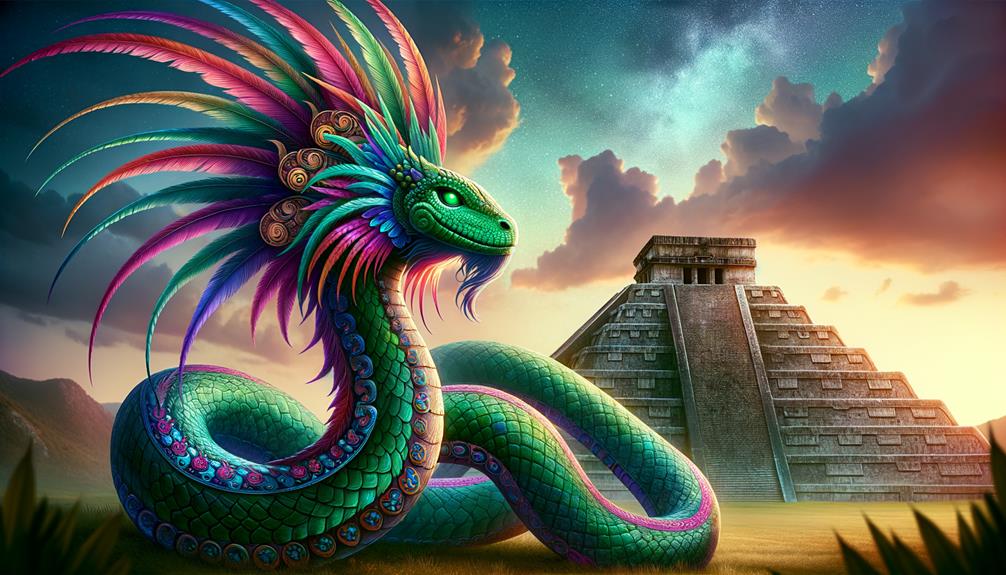
Quetzalcoatl's legend interweaves Aztec mythology, portraying him as both creator and savior – the manifestation of perpetual rebirth. Known as the Feathered Serpent, he symbolizes profound transformation, representing the archetypal hero's odyssey. In Mesoamerican folklore, Quetzalcoatl stands as a benevolent deity dedicated to shaping humanity and imparting wisdom.
One captivating tale recounts Quetzalcoatl's role in human creation. He journeys to the underworld, Mictlan, retrieving bones from previous beings. Sacrificing his blood, he breathes life into these remains, birthing a new human race. This narrative encapsulates the interplay of death and rebirth.
Quetzalcoatl's self-imposed exile and prophesied return hold great significance. His departure and eventual homecoming signify his cosmic role as a deity presiding over cyclical time and metamorphosis. Stories of his teachings, sacrifices, and ultimate journey embody the essence of renewal, making Quetzalcoatl an enduring symbol of hope and continuity in Mesoamerican cultures.
Cultural Significance
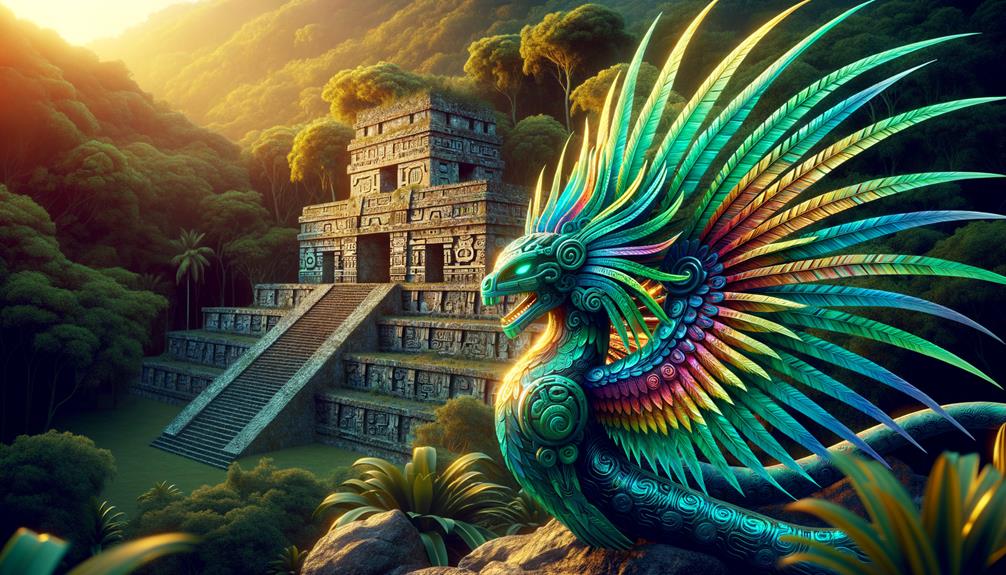
At the heart of Aztec society, Quetzalcoatl's presence permeated ceremonies and rituals, a symbolic representation of the eternal cycle of life, death, and rebirth. As a revered figure, his influence was profound, embodying the duality of existence through serpent imagery. The Templo Mayor in Tenochtitlan stood as a sacred gathering place where the Aztec people honored him, engaging in rites that echoed their deepest beliefs and aspirations.
Quetzalcoatl's significance transcended the Aztecs, resonating with the Maya and other Mesoamerican civilizations. His legends and prophecies spoke of a return, shaping their understanding of time and destiny. The veneration of this feathered serpent deity wasn't merely a ritualistic act; it was a profound connection to the rhythms of nature and the cosmos. Through this lens, we can perceive Quetzalcoatl as a guiding archetype in the hero's journey, a symbol of transformation and rebirth.
- The heartbeat of ancient ceremonies
- The aspirations woven into prophecies
- The interplay of life and death
- The spiritual focal point at Templo Mayor
- The shared reverence with the Maya
In this way, Quetzalcoatl remains an integral thread in the rich tapestry of Mesoamerican cultural heritage.
Iconography and Symbols
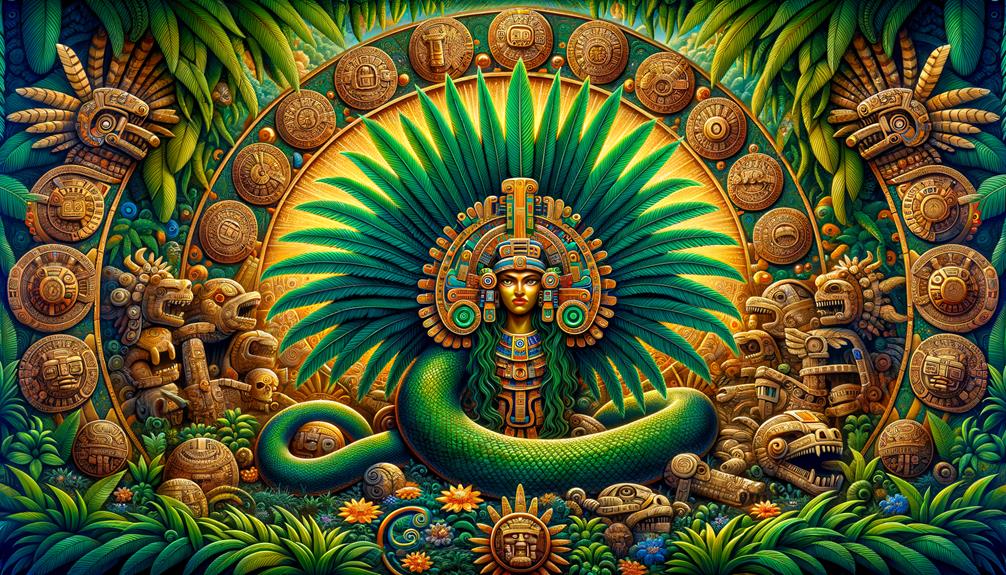
Quetzalcoatl's imagery in Mesoamerican art highlights the deep connection between the heavens and earth through his feathered serpent form. The bird and snake fusion symbolizes Quetzalcoatl as a link joining the divine and mortal realms.
In Teotihuacan artwork, Quetzalcoatl often represents fertility, intertwined with serpents signifying life, growth, and renewal – tying him to the earth's abundance and life-giving rains from above. The Aztecs embraced similar powerful iconography, depicting his serpent form adorned with feathers representing the terrestrial and celestial planes.
Over time, Quetzalcoatl's image evolved to a more human-like portrayal, often elaborately adorned, reflecting his divine status. However, his worship declined with the arrival of colonizers and Christianity, gradually diminishing this potent symbolism from the cultural landscape.
Nevertheless, Quetzalcoatl's enduring legacy as the feathered serpent continues inspiring, embodying the eternal link between heaven and earth through these iconic symbols.
Legacy and Influence
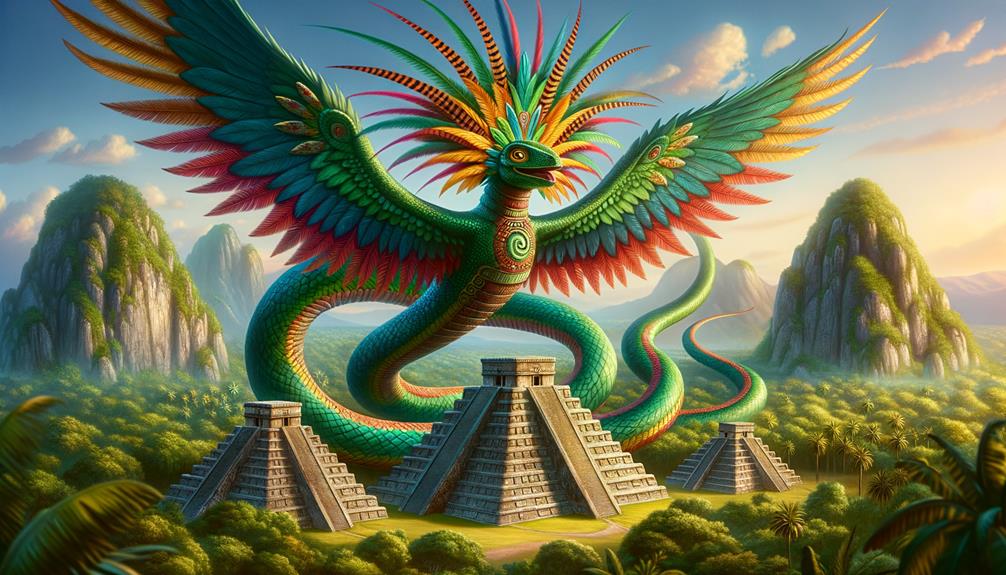
Throughout ancient Mesoamerica, the Feathered Serpent deity Quetzalcoatl stood as a profound archetype symbolizing wisdom, creation, and renewal. This mythological figure transcended mere imagery, becoming deeply woven into the belief systems of civilizations like the Aztecs, Maya, and Toltecs. Quetzalcoatl's presence is undeniable in the art, rituals, and stories passed down through generations.
Serpent symbolism found in Maya art and Aztec depictions underscore Quetzalcoatl's widespread veneration across cultures. While the Spanish conquest diminished open worship, the essence of this creation deity echoes through time.
Ancient murals and intricate carvings immortalize the majestic Feathered Serpent. Mythological tales recount Quetzalcoatl's heroic journeys. Cultural practices centered on renewal reflect the deity's symbolism. Spiritual traditions carried remnants of this revered figure. Even today, modern interpretations give new life to Quetzalcoatl's enduring legacy across former Mesoamerican societies.
Frequently Asked Questions
What Is Quetzalcoatl the God Of?
Visualize a divine force personifying wind's essence, wisdom's pursuit, and life's inescapable cycles. Quetzalcoatl's mythic odyssey epitomizes an everlasting quest for enlightenment, influence, and rejuvenation – a guide through existence's enigmas.
What Does the Feathered Serpent Symbolize?
The feathered serpent acts as a symbolic bridge between the heavens and earth, blending the divine with the mortal. This timeless symbol signifies transformation, rejuvenation, and the cyclical nature of existence across many mythological tales.
Emerging from primordial beliefs, the feathered serpent motif holds profound meaning, speaking to humanity's innate desire to connect the earthly realm with the mysteries of creation. Its serpentine form coils and sheds, embodying the perpetual cycles of birth, death, and rebirth that permeate our world. Meanwhile, the feathered component evokes celestial origins and transcendent ideals.
Civilizations like the Aztecs and Maya revered this archetype, weaving it into their cosmologies and visual arts. Even today, the feathered serpent maintains cultural relevance, resonating with modern seekers drawn to ancient wisdom and nature's regenerative powers.
Is Kukulkan the Serpent God or Quetzalcoatl?
Kukulkan and Quetzalcoatl, the renowned feathered serpents, transcend cultural boundaries. These mythical beings embody profound wisdom and cosmic equilibrium, bridging the Mayan and Aztec realms. As I delve into these ancient narratives, I perceive them as differing manifestations of a divine, heroic archetype.
Is Quetzalcoatl a Dragon God?
Quetzalcoatl transcends dragon symbolism. This feathered serpent embodies the profound intertwining of earth and sky realms. His mythos explores the archetype of creation and enlightenment, setting him apart from draconic legends. The revered serpent deity's journey reflects cycles of rebirth and wisdom, captivating cultures across ancient Mesoamerica.

